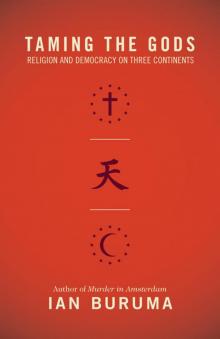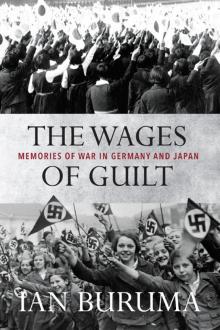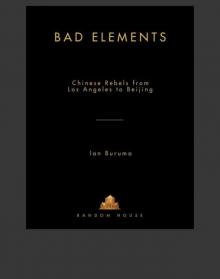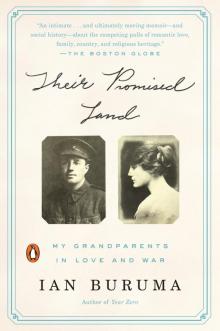- Home
- Ian Buruma
Year Zero Page 4
Year Zero Read online
Page 4
No doubt some women were freelance prostitutes, especially in the defeated countries where sexual services were the only way to keep oneself, or one’s children, alive. But even in the case of women who switched with perhaps unseemly haste from German to Allied lovers, the reasons were not always straightforward or venal. A freshly shaved “horizontal collaborator” from a small town in France told a self-appointed committee of purgers who threatened her with further punishment for her “immoral” behavior: “I don’t care if you shave my hair. I am no longer in touch with my husband [a former prisoner of war]. And I won’t let that stand in the way of having fun with the Americans, if I choose to.”18
Reading contemporary accounts and comments in the press, one might get the impression that the summer of ’45 was one long orgy indulged in by foreign servicemen and local women, out of greed, or lust, or loneliness. This impression appears to be confirmed by statistics: five times more women were hospitalized in Paris for sexually transmitted diseases (aka VD) in 1945 than in 1939. In Holland more than seven thousand illegitimate babies were born in 1946, three times the number in 1939. High STD rates can be explained by the lack of medical supervision or contraceptives, poor hygiene in poverty-stricken areas, or any number of other reasons. The fact is that many women and men were simply looking for warmth, companionship, love, even marriage. Much as the early months of liberation offered the chance for wild abandon, people also longed for a return to normality. It should not be forgotten that the 277,000 legitimate Dutch births in 1946 constituted the highest figure in the recorded history of the nation.
• • •
BERGEN-BELSEN WAS LIBERATED ON APRIL 12. British forces commanded by Lieutenant Derrick Sington were ordered to get there as quickly as they could. The war was not yet over, but conditions in the camp were so appalling that local people feared that a typhus epidemic—the same epidemic that had killed Anne Frank just weeks before—might spread to them. Since the German authorities could not or would not deal with the risk of a typhus outbreak, they agreed to let British troops enter Belsen, even though they were still at war.
Driving past piles of corpses and barracks stinking of excrement and rotting flesh, the soldiers could not quite believe what they were witnessing with their own eyes. Images from Belsen were among the first to be published in the Western press, and in Britain Belsen became the main symbol of Nazi mass murder. Brian Urquhart recalled that he had known about Nazi anti-Semitism: “Even so, the ‘final solution,’ the actual extermination of millions of people, was simply unimaginable. We were completely unprepared for Belsen.”19 What neither he, nor the other British soldiers, realized was that Belsen was not even an extermination camp. Those camps were in Poland, and most had already been destroyed by the Germans before retreating to the west.
Lieutenant Sington drove on, telling the survivors through a loudspeaker that they were free. Most were too far gone to respond in any way. Then he reached the main women’s camp, still holding his microphone:
In a few seconds the car was surrounded by hundreds of women. They cried and wailed hysterically, uncontrollably, and no word from the loudspeakers could be heard. The compounds of the camp were planted with young birch trees and the women plucked leafy sprigs and small branches and hurled them on to the car.20
These women were among the lucky ones. They could still walk. A British medical student, who had volunteered to help, came across the following scene in one of the barracks:
I was standing aghast in the midst of all this filth trying to get used to the smell which was a mixture of post-mortem room, a sewer, sweat, foul pus, when I heard a scrabbling on the floor. I looked down in the half light and saw a woman crouching at my feet. She had black matted hair, well populated and her ribs stood out as though there were nothing between them . . . She was defecating, but she was so weak that she could not lift her buttocks from the floor and, as she had diarrhoea, the liquid yellow stools bubbled over her thighs.21
The doctors and medical volunteers were desperate for more food, drugs, and medical equipment. They were faced with disease and famine on a scale they had never experienced, or even imagined was possible. Hundreds of people were still dying every day, sometimes from eating army rations that were too rich for their shrunken intestines. But the army is not always an efficient institution, and conditions in Germany were chaotic. One day in late April a mysterious consignment arrived containing large quantities of lipstick.
It turned out to be a godsend. The commanding officer of a British ambulance unit, Lieutenant Colonel Gonin, remembers:
I believe nothing did more for those internees than the lipstick. Women lay in bed with no sheets and no nightie but with scarlet lips, you saw them wandering about with nothing but a blanket over their shoulders, but with scarlet lips . . . At last someone had done something to make them individuals again, they were someone, no longer merely the number tattooed on the arm. At last they could take an interest in their appearance. That lipstick started to give them back their humanity.22
Richard Wollheim, later to become a famous British philosopher, was an intelligence officer. Like Urquhart, he was sent briefly to Belsen, in May, when conditions were still terrible, but not quite as catastrophic as they had been. It had been decided somewhere in the army hierarchy that it would be a good idea to organize a dance party for the soldiers and the survivors at Belsen. Wollheim was told to organize the event. It was, alas, a disaster, for as the band of Hungarian camp guards (who had had a reputation for brutality), dressed up in national folk costumes, struck up a dance tune on their concertinas, there was a misunderstanding. Without a language in common, the women bared their arms to show their camp tattoos. The men, literally at a loss for words, grabbed the women’s arms hoping for a dance. The women, terrified, started hitting the men, while the Hungarians played faster and faster.23
This, however, was an unusual mishap. There was another dance party held around the same time on a square between the barracks, with a Royal Air Force band providing the music. In the account of a British soldier, it was a huge success, even though some of the girls “could hardly walk,” while others “looked as though they’d break in two.” One very tall Canadian officer held a tiny girl, whose head only came up to his waist. They waltzed together. “She looked so happy, it was hard for those who saw her not to smile or cry.”24
This was perhaps a more typical story than Wollheim’s, for many people who worked in the camps, from American rabbis to United Nations relief workers, remarked with various degrees of approval or disapproval on the speedy recovery of sexuality among the survivors. Like the lipstick, sexual desire restored a sense of humanity to people, who had been left with none.
If the birthrate in Holland was high in 1946, the birthrate in the displaced persons camps was higher. In the American occupation zone alone 750 babies were born every month in the DP camps. Nearly one-third of the Jewish women in the zone between the ages of eighteen and forty-five had already given birth or were expecting babies.25 Former concentration camps, including Bergen-Belsen, where so many thousands had died under the worst possible conditions, had become sites of feverish sexual activity, as though the survivors couldn’t wait to show to themselves and the world that they were still alive, and not just that, but capable of producing life.
Relief workers were sometimes shocked and spoke of DPs, often Jewish, giving “themselves up to debauch without restraint.” Some put it down to boredom. What was there to do but drink and have sex? Some were more moralistic. A French doctor working for a charity organization wrote with evident disapproval, “The moral standings of many of these survivors from the concentration camps is very low . . . sexual irregularity has reached appalling proportions.” But he concede;d that there were mitigating circumstances. One could not really blame the young girls who had passed through hell, and “are now seized by an irresistible desire for affection and forgetfulness, which they seek to satisfy with the m
eans at their disposal.”26
Other observers had more elaborate explanations. A Polish relief worker named Marta Korwin believed that concentration camp victims had dreamed that an end to their torment would lead to the dawn of a perfect world: “All their past difficulties would be forgotten, freedom would take them back to a world where nothing had ever gone wrong . . .” When instead they found themselves living in the misery of DP camps, having lost their loved ones, with no hope, they escaped into drink or sex.27
All these explanations are perfectly plausible. But there was also a biological dimension. A people in severe crisis had to reproduce itself to survive. Many Jews in the DP camps were not death camp survivors, of whom there were few. Many came from parts of the Soviet Union, where they had found refuge from the Nazis. But most Jews had lost children, parents, siblings, or other relatives. Older people had little choice but to live with ghosts. But young people craved new family ties, others to live for. And biological regeneration was officially promoted by Zionists and other Jewish organizers. Marriages happened within weeks, even days after first encounters. Contraceptives were frowned upon in the Jewish DP camps. People felt duty-bound to produce as many children as they could. Sex was not just a pleasure; it was an act of defiance against extinction.
• • •
TO BE A GERMAN or Japanese in 1945 was obviously a rather different experience than being French, Dutch, or Chinese, let alone Jewish. This applies to the encounter with foreign troops too. The Amis (German slang for Yanks), or Ameko (the same in Japanese), as well as the Canadians, Australians, British, and Soviets came not as liberators, but as conquerors. The same was true, to some extent, even for many Italians, especially in southern Italy, where the Allied invasions made already hard lives even harder. Cities were bombed to pieces, economic conditions were dire. Prostitution was in many cases a necessity.
In Berlin, they were known as Ruinenmäuschen, “mice in the ruins,” girls and women prowling the rubble of their city trying to pick up a soldier for a bit of cash, some food, or cigarettes. Some girls, barely into puberty, plied their trade in improvised brothels in the ruins, run by black marketers. Boys had their own Trümmerbordellen (“ruin brothels”), where they sold themselves to American soldiers, one of whom, known as Tante (“Aunty”) Anna, became a notorious figure in the underworld of Frankfurt.
Survival often dissolved class distinctions. Norman Lewis was a young British army officer stationed in Naples. In his wonderful account, Naples ’44, he describes the visit to his HQ of a grand Italian aristocrat, owner of a palazzo somewhere in the south. He arrived with his sister:
Both are remarkably alike in appearance: thin, with extremely pale skin and cold, patrician expressions bordering on severity. The purpose of the visit was to enquire if we could arrange for the sister to enter an army brothel. We explained that there was no such institution in the British Army. “A pity”, the prince said. Both of them speak excellent English, learned from an English governess. “Ah well, Luisa, I suppose if it can’t be, it can’t be.” They thanked us with polite calm and departed.28
In Japan, prostitution was institutionalized from the beginning. They had their reasons. Japanese authorities were terrified that Allied soldiers would do to the Japanese what Japanese troops had done to the Chinese and other Asians. When Nanking was sacked in 1937, and Manila more or less destroyed in a last-ditch battle in 1945, tens of thousands of women were raped, mutilated, and usually killed, if they hadn’t died of the ordeal already. These were two particularly bad instances. There were many more. In China, rape by Imperial Japanese soldiers was perpetrated on such a massive scale that it became a military problem, by provoking fiercer Chinese resistance. To cope with this difficulty girls were sometimes drafted, but mostly kidnapped, especially in Korea and other countries under Japanese control, to serve as so-called comfort women, meaning sex slaves, in Japanese army brothels.
Government and military propaganda had frightened Japanese citizens with constant predictions that, in the case of defeat, Japanese women would be raped, tortured, and murdered by foreign soldiers. To prevent this ghastly and dishonorable fate, Japanese were ordered to fight to the death, or kill themselves. Women and children in the Pacific islands and in Okinawa were ordered to blow themselves up with hand grenades or jump off cliffs. Many did.
And so, on August 18, three days after the Japanese surrender, the Home Ministry ordered local police officials to set up “comfort facilities” for the conquering Allies. Women were recruited to “sacrifice their bodies” in the Recreation and Amusement Association (RAA) as a patriotic duty. The former prime minister, Prince Konoe Fumimaro, who bore a large responsibility for starting the Pacific War, told the national police commissioner to “please defend the young women of Japan.”29 Perhaps the invading foreigners would be appeased by this measure, and so respectable Japanese women might be able to come out of their hiding places and walk the streets unmolested.
It must have been a sordid business. Recreation and Amusement facilities were set up in such haste that there were no beds to accommodate the soldiers and the sacrificial women. Sexual intercourse took place wherever space could be found, mostly on the floors, or in the halls and corridors of the improvised brothels. It took a few months for the Japanese to come up with more efficient arrangements. A huge, hangarlike brothel was built in Funabashi, outside Tokyo, known as the International Palace, or IP. The IP offered sex on a kind of assembly line, known as “the willow run” after the wartime bomber factory built by Ford near Detroit. Men would leave their shoes at the entrance of the long building, and pick them up polished to a sheen at the other end.
Army billets, such as the Nomura Hotel in Tokyo, were swarming with women, identified as clerks or cleaning ladies, who regularly spent the nights there. Some of them brought their families to escape from the winter cold. A big dance hall in the center of Tokyo had a sign in Japanese that read: “Patriotic Girls! Assist the Reconstruction of Japan by Serving as Dance Partners!”30 Condoms were sold at the army PXs (special stores selling food, clothing, and other supplies to members of the occupation forces).
In contrast to Germany, there was no strict ban on “fraternization with indigenous personnel” in Japan at first. General Douglas MacArthur, the Supreme Commander for Allied Powers (SCAP), recognized the futility of this rule. He told one of his aides: “They keep trying to get me to stop all this Madame Butterflying around. I won’t do it . . . I wouldn’t issue a non-fraternization order for all the tea in China.”31
In the beginning of the occupation there were about six hundred thousand U.S. soldiers in Japan, in addition to Australians, British, and a sprinkling of other nationalities. So there was a great deal of fraternizing. A letter written by William Theodore de Bary, a U.S. Navy officer who later became a distinguished scholar of China and Japan, described what it was like in Sasebo, a large naval base on the island of Kyushu, in October 1945:
Fraternization itself has been a problem. The MPs, in fact, had to forbid any more congregating on the large bridge by our headquarters, so congested had it become with eager marines talking and using sign language to grinning and friendly Japanese. It has been that way from the first.32
This went on despite some extraordinarily racist propaganda back home. This, for example, from an article about the occupation of Japan in the Saturday Evening Post: “The flat-chested, button-nosed, splayfooted average Japanese woman is about as attractive to most Americans as a 1000-year-old stone idol. In fact, less so. They like to take pictures of the idols.”33
The author of this article, if we choose to be charitable, had no idea. Most of SCAP’s senior officers had secured Japanese mistresses already in 1945. Since there were very few Western women at first, this was to be expected. Things changed only when a new wave of military officers arrived, less tolerant men who often had had no direct experience of combat. Even as restrictions in Germany had been lifted, they decided to
impose more discipline in Japan by declaring most public places, such as local restaurants, hot spring resorts, cinemas, or army hotels, “off-limits.”
As a result, fraternization still took place, just more discreetly, and more and more with freelance prostitutes, which did nothing to keep the VD rates down. In the bombed-out streets and city parks prostitutes had their own territories, known as “islands.” Some could be had for as little as one dollar, which was roughly the price of half a pack of cigarettes on the black market. This type of business thrived, especially after the Allied administration decided, much against Japanese advice, to ban organized prostitution in 1946.
Japanese like to categorize things neatly. The freelance hookers, known as panpan girls, were divided into those who specialized in white foreign soldiers, black foreign soldiers, and Japanese only, even though some of the more enterprising ones refused to make such neat distinctions. Some prostitutes, the so-called onrii (as in “only one”), managed to latch on to one client. The more than usually promiscuous ones were batafurais (butterflies). Certain areas of central Tokyo, such as Hibiya Park, opposite General MacArthur’s headquarters, or nearby Yurakucho station, were typical panpan stamping grounds.34
The panpan, heavily lipsticked and high-heeled, was an object of Japanese scorn, as the symbol of national degradation, but also of fascination, tinged with envy. They were materially better off than most homeless, hungry, impoverished Japanese citizens. These working girls were also the first and most avid consumers of American goods, and more familiar than most Japanese with the popular culture of the victors. Using the peculiar argot of the panpan, Japanese slang mixed with broken GI English, they were also closer to speaking the language of the occupiers than most Japanese could manage.

 A Japanese Mirror
A Japanese Mirror Taming the Gods
Taming the Gods The China Lover
The China Lover A Tokyo Romance
A Tokyo Romance Theater of Cruelty
Theater of Cruelty Year Zero
Year Zero The Wages of Guilt
The Wages of Guilt Murder in Amsterdam
Murder in Amsterdam Bad Elements
Bad Elements Their Promised Land
Their Promised Land Occidentalism
Occidentalism Anglomania
Anglomania Inventing Japan: 1853-1964 (Modern Library Chronicles)
Inventing Japan: 1853-1964 (Modern Library Chronicles) The Missionary and the Libertine
The Missionary and the Libertine